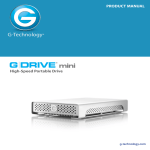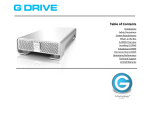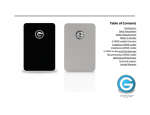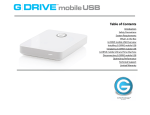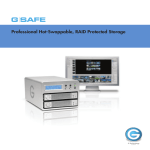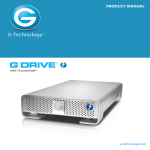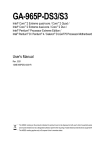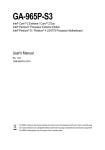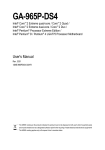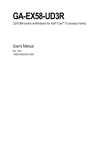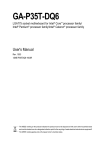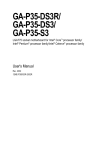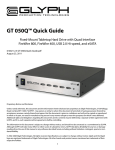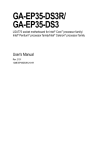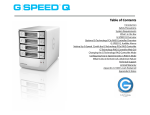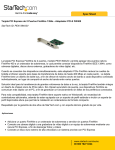Download G-RAID mini User Manual
Transcript
Table of Contents Introduction Safety Precautions System Requirements What’s in the Box G-RAID mini Overview Installing G-RAID mini G-RAID mini Warning LED Operation RAID Levels Explained Configuring G-RAID mini Configuring G-RAID mini for RAID 1 mode Configuring G-RAID mini for RAID 0 mode Initializing G-RAID mini Configuring G-RAID mini for Cross-Platform Use Disconnecting G-RAID mini Optimizing Performance Technical Support Limited Warranty Introduction Thank you for purchasing the G-RAID™ mini from G-Technology™, G-RAID mini hard drives from G-Technology are the ideal storage solutions for professionals on the go. G-RAID mini is capable of delivering an unprecedented 120+ MB/second transfer rate when connected via eSATA in RAID 0 mode. G-RAID mini is FireWire™ bus-powered even when connected via eSATA so you do not need to be connected to AC power. G-RAID mini has 120+ MB/second data transfer rates via the eSATA port. It supports multi-stream HDV, DVCPro™ HD, XDCAM™ HD, ProRes™ 422 and uncompressed SD workflows. Access G-RAID mini by its high-speed Interface eSATA, FireWire 800 (FireWire 400 via included cable) or USB 2.0 ports. NOTE: G-RAID mini is formatted for the Mac OS and will mount on the desktop right out of the box. For details on reinitializing the G-RAID mini, using the G-RAID mini on Windows®, or for using the G-RAID mini for both Windows and Mac, click here. G-RAID mini is a high-speed, low-cost portable RAID designed specifically for professional content creation applications. G-RAID mini features either RAID 0 (performance) or RAID 1 (protection) operation, a high-speed quad interface and storage capacities up to 1TB. G-RAID mini is the ideal portable storage solution for safeguarding content transferred from professional tapeless video cameras. Its compact size and tough, all-aluminum enclosure makes it perfect for capturing and editing on the go or while working on location. Safety Precautions The disk drive contained in your G-RAID mini is a delicate electronic instrument and is susceptible to damage due to excessive physical shock. Place the unit in a vented area away from moisture or liquids. Please handle the unit with care. Do not open the case. Doing so will void the warranty. If the product is returned with damage caused by improper handling, the warranty will be void and liability will rest with the user. 2 System Requirements G-RAID mini Overview • eSATA/FW800/FW400/ USB 2.0 operation • Mac OS X 10.2.4 or higher • Windows XP/ Vista/ Windows 7 Note the various features of the G-RAID mini. There is a Power and Activity LED and a Yellow Drive Failure LED on the front of the unit and a cooling fan on the bottom. On the rear of the unit is 1 eSATA port, 2 FireWire 800 ports, a USB 2.0 port, an On/Off Switch and a Power Connector. What’s in the Box Note: Take a moment to ensure that the following items are included in the box. G-RAID mini • G-RAID mini disk array (eSATA/FW800/FW400/ USB 2.0) • Installation CD-ROM • eSATA cable • FireWire 800 Cable (9 Pin to 9 Pin) • FireWire 800 to 400 cable (9 Pin to 6 Pin) • USB 2.0 cable • External Power Supply If anything is missing, please call G-Technology at (310) 449-4599. For more details on this, click here. 3 Attention Mac OS X Users G-RAID mini is set up at the factory for use with Mac OS X systems. If you are running Mac OS X, G-RAID mini will mount on the OS X desktop right out of the box as one large disk. If it becomes necessary to re-format G-RAID mini for Mac OS X, go here. Attention Windows Users G-RAID mini must be formatted for the Windows Operating System before using the G-RAID mini. For more information about using the G-RAID mini for Windows XP/ Vista/ Windows 7 use, please visit: http://www.g-technology/support/windows Attention Cross-Platform Users G-RAID mini can be used on both Mac and PC systems by formatting the drive “FAT32.” There are some limitations when using FAT 32. Alternatively you can install software on the Windows Machine such as “MacDrive” which will allow you to mount Mac formatted drives on your PC. For more information about using the G-RAID mini for cross-platform use, go here. 4 Installing G-RAID mini G-RAID mini attaches to your computer via an eSATA, USB 2.0 or FireWire 800 port. FireWire 400 connectivity is handled by a 9 to 6 pin cable (included). With the computer powered down, choose the connection appropriate for your system and connect G-RAID mini with the supplied cable. Connect the supplied power cord to the Power Supply and plug the other end into a surge protector or wall outlet. Power up your computer and the G-RAID mini will mount on the desktop. Note: When using FireWire 800, it is not necessary to use the power adapter. You can use the FireWire 800 cable to power the unit for eSATA connectivity, but you must install the eSATA cable before connecting the FireWire cable. NOTE: In the event of a disk drive failure, the Yellow Drive Failure LED located behind the front panel of G-RAID mini will illuminate. If the unit was configured in fail-safe RAID 1 mode all the data stored on the system is intact. If configured in RAID 0 mode all data will be lost. Please contact G-Technology Technical Support if the Drive Failure LED illuminates for corrective action. RAID Levels Explained G-RAID mini can be configured in RAID 0 (Performance) mode or RAID 1 (Fail-Safe) mode. The following table will explain the advantages and disadvantages for each RAID level. RAID Level Storage Capacity Protection Level Ideal For: G-RAID mini LED Operation 0 100% Low G-RAID mini contains LEDs for operations for the following: System Boot Up, System Activity, Disk Activity and Disk Drive Failure. The following table will guide you in understanding the meaning of each combination of LEDs on the unit. Video Editing 1 50% High Sensitive Data System Boot Up System Ready Disk Activity Disk Drive Failure Configuring G-RAID mini Activity/ Power LED Drive Failure LED Flashing On On Off G-RAID mini is set up at the factory for use with Mac OS X systems. If you are running Mac OS X, G-RAID mini will mount on the OS X desktop right out of the box. If it becomes necessary to re-format G-RAID mini, follow the instructions below. Flashing Off Note: G-RAID mini ships from the factory in RAID 0 mode. On On • For Mac OS X configurations see below 5 • For Windows XP/Vista /Windows 7 installations go here: http://www.g-technology/support/windows • For cross-platform use, go here. Configuring G-RAID mini for Mac OS X Please refer to the instructions below when configuring G-RAID mini. correctly. NOTE: It is important that you copy The Configurator to your Applications folder by Option + dragging it there prior to running it. You can also launch the utility directly from the mounted Disk Image. The Configurator will not work if you merely drag the application to the Applications Folder and then attempt to launch it. RAID 0: If you need RAID 0 mode, it is not necessary to change anything, as G-RAID mini comes from the factory in RAID 0 mode. If you need to re-configure a G-RAID mini from RAID 1 to RAID 0, then follow the instructions here. Configuring G-RAID mini for RAID 1 Mode RAID 1: If you need RAID 1 mode for G-RAID mini, then follow the instructions below. WARNING: Changing the RAID level will erase any data stored on G-RAID mini. The Configurator: You will need a software Utility from G-Technology called The Configurator to change the RAID level for your G-RAID mini. To configure G-RAID mini for RAID 1, do the following. Follow the directions below to configure G-RAID mini in fail-safe RAID 1 (mirroring) mode. 1. Launch the G-Technology Configurator utility located on the CD that ships with the unit. The following window will appear. The Utility is available on the enclosed CD or you can download it from the support area of the G-Technology website here. NOTE: It is important that you are connected via USB 2.0 while using The Configurator with your G-RAID mini. If you are connected any other way, the utility will not function 6 2. Click on the Continue button. The following window will appear. 4. Select the RAID 1 (Protected) radio button as shown below and click the Configure button to continue. 5. The following window will appear. Click on the OK button to continue. NOTE: Since you are connected via USB, the search process may take a few minutes. 3. Once the utility finds your G-RAID mini, the following window will appear. 6. The following window will appear. Click on the Yes button to continue. 7. The following window will appear. 7 initializing G-RAID mini for use with Mac OS X. Initializing G-RAID mini If the Disk Insertion dialog did not launch, you’ll need to open Apple Disk Utility in order to initialize the disk for Mac OS X. Apple Disk Utility is in the Utilities Folder located in the Applications Folder on the Macintosh HD (or press Shift + Command + U to open the Utilities folder). 8. After the following window appears, your G-RAID mini is configured in RAID 1 mode. After launching Disk Utility, a window like the following will appear. 9. Since you don’t have a partition set up for G-RAID mini, the following window will appear. Click on the Initialize button to continue. After clicking the Initialize button, Apple Disk Utility will launch. Refer to the following section for information on A USB icon representing the G-RAID mini will be displayed in the left-hand column. 8 3. Click on the Partition button. Under Volume Scheme, choose 1 Partition. 18. Rename the Volume: G-RAID mini or any other name you wish in the Name field. 19. Click the Apply button. 17. Click the Options button to choose the proper partition scheme. Click the radio button for GUID Partition Table, then click OK. 20. The Partition Disk dialog launches, warning you that all data will be erased. Click the Partition button. 9 21. Apple Disk Utility begins the formatting process. Upon completion, the G-RAID mini is fully functional. However, you will want to restore the original G-RAID mini icon. Restoring the G-SPEED Q Icon You will see the standard icon for USB after completing the formatting process. If you desire to return the standard G-RAID mini icon, complete the following steps. 3. Press Command + C to copy the icon. 4. Select the G-RAID mini USB icon on the Desktop and press Command + I. 5. Select the USB Icon in the “Get Info” window (left) 6. Press Command + V to paste the icon into the Get Info window (right). Restore the icon by doing the following: 1. Go to the G-Technology website and download the “icon package”. Click here to download the package. 2. Once downloaded, select the icon for the G-RAID mini in the G-Technology Icons disk. 10 2. Choose RAID 0 in the Configure dialog box and click the Configure button, as shown in Step 4. 3. Continue with Step 5 to complete the process. Cross-Platform Use To setup your G-RAID mini for use on both Windows and Macintosh systems, use Apple Disk Utility to format the drive using the MS-DOS FAT format. NOTE: Prior to setting up G-RAID mini for Cross-Platform use, make sure that the unity is configured in the desired RAID mode. The icon for your G-RAID mini has now been restored. 1. Open Apple Disk Utility. Apple Disk Utility is in the Utilities Folder located in the Applications Folder on the Macintosh HD (or press Shift + Command + U to open the Utilities folder). You can now close the Get Info window. 2. Select the G-RAID mini icon from the left-hand column, then click on the the Erase button at the top. After reinitializing the drive and restoring your icon, your G-RAID mini is ready for use. 3. Select MS-DOS File System from the drop down menu, as shown. Configuring G-RAID mini for RAID 0 Mode If you have configured G-RAID mini as RAID 1 and you wish to re-configure G-RAID mini in RAID 0 (performance) mode. Do the following. 1. Follow the instructions here for configuring G-RAID mini as RAID 1 until you get to Step 3. 11 6. Click the Erase button and your drive will be formatted to its full capacity as FAT32. With this format, you will be able to READ/WRITE on both Windows and Mac OS X Machines. NOTE: You could format your drive on a Windows Machine as FAT 32, however Windows limits FAT32 partitions to 32 GB in size. 5. Click the Erase button and the following dialog box will appear. NOTE: The MS-DOS File System cannot write files over 4 GB. If you are working with files over 4 GB, you may wish to choose a software option like MacDrive. MacDrive is Windows software that enables the Windows OS to mount Mac formatted drives. See the MacDrive website for more info. WARNING: THIS NEXT STEP WILL ERASE ALL DATA ON YOUR DRIVE. Disconnecting G-RAID mini 4. Enter G-RAID mini in the Name field. A great feature of G-RAID mini is its ability to be connected and disconnected while your computer is running. To prevent failures and/or data loss it is important to follow the steps below when disconnecting or “unmounting” the G-RAID 12 mini from your computer. Mac OS X Computers 1. Before powering down and disconnecting G-RAID mini, you must unmount the system by simply dragging the G-RAID mini icon to the trash located in the dock. 2. It is now safe to power off and remove GRAID mini from your system. Optimizing Performance G-RAID mini can be connected to any Mac or PC that has an eSATA, FW800 or USB 2.0 ports. FW400 can be accessed by a 9 to 6 pin cable. For best performance, G-RAID mini should be connected via eSATA. Technical Support G-Technology appreciates and values its customers, striving to give you the finest service and support. If you encounter any difficulties while installing the G-RAID mini, or if the GRAID mini needs maintenance, please contact G-Technology Technical Support via one of the following ways: Telephone: (310) 449-4599 Fax: (310) 449-4670 E-mail: [email protected] Internet: http://www.g-technology.com of your computer and have the following information readily available: • Your G-RAID mini serial number (on bottom of unit) • Operating system and version • Computer brand and model • Amount of memory installed • Other devices attached to your computer Thank you for purchasing G-RAID mini. If you have any comments or questions about this manual or the product, please call (310) 449-4599, or send an email to [email protected] Limited Warranty Hitachi Global Storage Technologies (“Hitachi GST”) including G-Technology by Hitachi Limited Warranty for External Hard Disk Drives What does this limited warranty cover? This Limited Warranty applies to new Hitachi GST external storage products purchased from an authorized Hitachi GST dealer by the original purchase for normal use and not for resale. Hitachi GST warrants that a covered product is free from defects in materials and workmanship, with the exceptions stated below. How long does limited warranty coverage last? This limited warranty lasts for 1 year, 2 years, 3 years or 5 years, or a fixed period from date of purchase, depending on when and where it was originally purchased. To determine the warranty specifically for your product, visit When contacting Technical Support, make sure to be in front 13 www.g-technology.com . A valid proof of purchase may be required to prove eligibility. If you do not have a valid proof of purchase, the limited warranty period will be measured from the date of sale from Hitachi GST to the authorized distributor. What does this limited warranty not cover? The limited warranty does not cover damage resulting from commercial use, misuse, accident, modification or alteration to hardware or software, tampering, unsuitable physical or operating environment beyond product specifications, improper maintenance, or failure caused by a product for which Hitachi GST is not responsible. There is no warranty of uninterrupted or error-free operation. There is no warranty for loss of data—you must regularly back up the data stored on your product to a separate storage product. There is no warranty for product with removed or altered identification labels. HITACHI GST DOES NOT PROVIDE ANY OTHER WARRANTIES OF ANY KIND, INCLUDING, BUT NOT LIMITED TO, THE IMPLIED WARRANTIES OR CONDITIONS OF MERCHANTABILITY AND FITNESS FOR A PARTICULAR PURPOSE. SOME JURISDICTIONS DO NOT ALLOW THE LIMITATION OF IMPLIED WARRANTIES, SO THIS LIMITATION MAY NOT APPLY TO YOU. Hitachi GST is not responsible for returning to you product which is not covered by this limited warranty. What must you do? If you are having trouble with a product, before seeking limited warranty service, first follow the troubleshooting procedures that Hitachi GST or your reseller provides. To obtain limited warranty service, you must first obtain a Return Materials Authorization (RMA) and ship-to address by contacting G-Technology by Hitachi at http://www.g-technology.com/support Please follow the instructions found on the website. You must return the covered hard disk drive using approved packaging to our logistics center. You must pay any associated transportation charges, duties and insurance in shipping the drive to our logistics center. You should remove all personal information from the product prior to its return. What will Hitachi GST do? Hitachi GST will repair or replace covered defective product and ship you repaired or replaced product, transportation prepaid. You receive title to the repaired or replaced product at delivery to carrier at Hitachi GST shipping point. You are responsible for importation of the repaired or replaced product, if applicable. These limited warranty terms apply to the repaired or replaced product, except the limited warranty period is for the greater of the remainder of the original limited warranty period for the returned product or 90 days. How is our liability limited? HITACHI GST AND ITS AFFILIATES, SUPPLIERS, DISTRIBUTORS, AND RESELLERS ARE NOT LIABLE FOR ANY OF THE FOLLOWING: 1) THIRD-PARTY CLAIMS AGAINST YOU FOR DAMAGES (OTHER THAN BODILY INJURY INCLUDING DEATH AND TANGIBLE PERSONAL PROPERTY; 2) LOSS OF, OR DAMAGE TO, YOUR DATA; OR 3) SPECIAL, INCIDENTAL, OR INDIRECT DAMAGES OR FOR ANY ECONOMIC CONSEQUENTIAL DAMAGES (INCLUDING LOST PROFITS OR SAVINGS), EVEN IF INFORMED OF THE POSSIBILITY. SOME JURISDICTIONS DO NOT ALLOW LIMITATION OF LIABILITY, INCIDENTAL DAMAGES, OR CONSEQUENTIAL DAMAGES, SO 14 THE ABOVE LIMITATIONS MAY NOT APPLY TO YOU. How do local laws apply? THIS LIMITED WARRANTY GIVES YOU SPECIFIC LEGAL RIGHTS, AND YOU MAY ALSO HAVE OTHER RIGHTS WHICH VARY FROM JURISDICTION TO JURISDICTION. G-Technology, a division of Hitachi Global Storage Technologies Korea and Taiwan. Contact Hitachi for further information. Hitachi shall not be liable to third parties for unauthorized use of Hitachi trademarks. One gigabyte (GB) is equal to one billion bytes and one terabyte (TB) equals 1,000 GB (one trillion bytes). Accessible capacity will vary from the stated capacity due to formatting and partitioning of the hard drive, the computer’s operating system, and other factors” For G-Technology by Hitachi products less than 1TB: “One gigabyte (GB) is equal to one billion bytes when referring to hard drive capacity. Accessible capacity will vary depending on the operating environment and formatting. Tel: (310) 449-4599 Fax: (310) 449-4670 [email protected] G-Technology by Hitachi Global Storage Technologies © 2010. All rights reserved. G-DRIVE, G-RAID, G-SAFE, and G-SPEED are registered trademarks of G-Technology by Hitachi GST. Apple, Mac, Macbook, Macbook Pro and the Mac logo are trademarks of Apple, Inc. Hitachi Global Storage Technologies and Hitachi Inspire the Next are trademarks of Hitachi Ltd. G-Technology is a trademark of Hitachi Global Storage Technologies. All other trademarks are the property of their respective owners. Hitachi Global Storage Technologies trademarks are authorized for use in countries and jurisdictions in which Hitachi has the right to use, market and advertise the brands. The Travelstar trademark is authorized for use in the Americas, EMEA and the following Asia-Pacific countries and jurisdictions: Australia, Hong Kong, Japan, New Zealand, South 15















